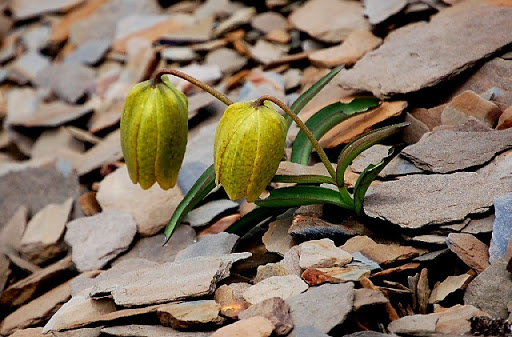Researchers have studied that a flowering plant, Fritillaria delavayi is evolving and turning its green colour into dark grey to blend into rocks to avoid detection by harvesters.
Let’s start with a question, what comes to your mind when you think of the word – Evolution? Evolution is a magnificent theory, but plants don’t often come to our minds when we think of the process. There are immense number of examples of animal’s evolutionary paths diverting around humans, but when the conversation turns towards plants, we don’t have plenty of cases indicating evolution.
This biological trend of evolution is now being followed by one flowering plant in China as the plant is getting evolved to make it harder for humans to find it. Researchers in China have discovered a wildly growing plant that has adapted by developing camouflage that makes it less likely to get picked by humans.
Fritillaria delavayi is a flowering plant that is typically used in Chinese medicine and produces a flower of green colour after five years. For thousands of years, the plant has grown slowly on the rocky slopes of the Hengduan mountains in China and the dried bulbs of the flowers are used to treat heart and lung ailments. Initially, the plant was not hard to find, but because of its medicinal uses and its growing demand, commercial harvesting of the plant intensified making it less available.
In an attempt to achieve greater survival, the medicinal plant Fritillaria delavayi, which grows on the rocky terrain of the Hengduan mountains in China, has evolved to match their surroundings or camouflage, especially in the area where they are extensively harvested by human beings. The plant is now rapidly evolving by changing its bright green flowers to grey and brown leaves and flowers to avoid detection.
In a study published in Current Biology by the Kunming Institute of Botany (Chinese Academy of Sciences) and the University of Exeter, it was found that humans are the primary factor in the changing colour of the medicinal plant. The study clearly suggests that humans have a direct and dramatic impact on the coloration of wild organisms, not just on their survival but on their evolution as well.
Evolution – means of survival
Fritillaria delavayi has been growing in China for thousands of years now and is used in traditional medicine. But the plant has vanished from sight, camouflaging with the rocks due to its growing commercial harvesting. The plant has evolved to become less visible to the human eye in order to save itself from extinction.
Since the plant and its uses have become known to many, there is a spike in its harvesting that threatens the plant’s survival. The rising commercial value of the plant in recent years has served as a factor for its increased harvesting.
Much like how several species of animals such as chameleons and octopuses have evolved to hide from predators, various species of flora like Monotropsis odorata (also called sweet pinesap) and Corydalis hemidicentraI (kind of herb), are known to blend with their surroundings to evade predators such as grazing animals and insects.
Did this evolution is driven by humans?
During the study, the researchers measured how closely the plants from varying populations matched their backgrounds in the mountain and how easy they were to collect. They also interviewed people to estimate how the harvesting of these plants took place in specified locations. Based on the computer experiment, it was suggested that it takes more time to harvest camouflaged plants. This indirectly suggests that humans have influence in the rapid evolution of this species into forming a new colour.
The study shows that the plants which stick to their dark colouring are also located in the most heavily harvested areas, suggesting a direct correlation between the plant’s coloration and human intervention.
Scientists have discovered that the colour of Fritillaria delavayi leaves has become more camouflaged – matching the background rocks on which they grow. The researchers firstly believed that the evolution of camouflage of the plant had been driven by herbivores, but then with no trace of animals, the scientists involved in the study realised that humans could be the reason behind such change of colour of the plant’s leaves and flowers.

